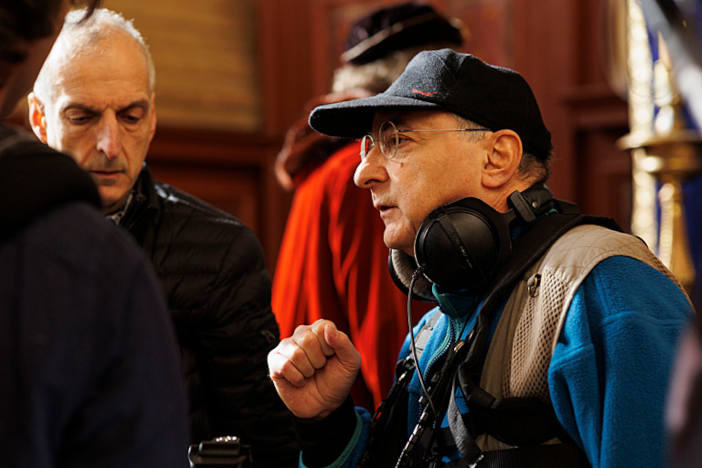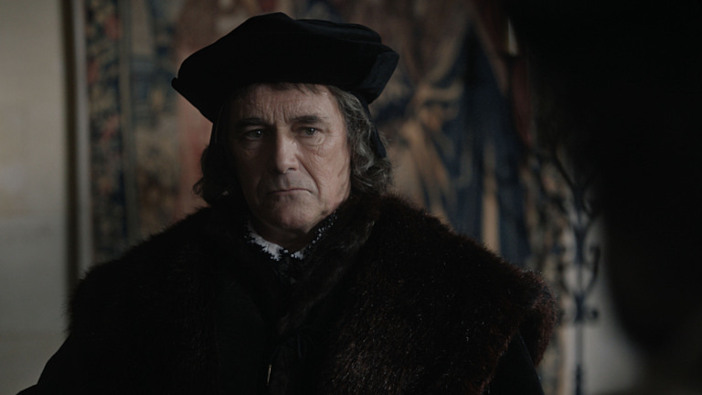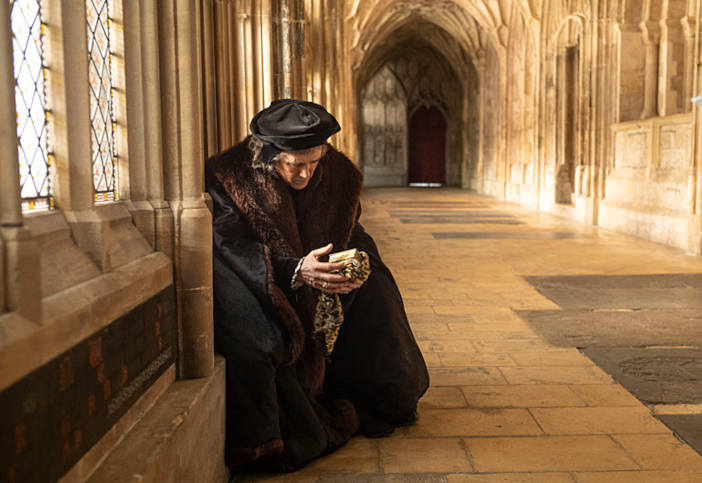As Wolf Hall continues to hold court on Sunday nights, director, photographer and Arb screen critic, Paul Joyce, ruminates on the use of camera shots and how they can make or break a scene. Leave your comments and feedback at the end of the article!
“Directing is 90% casting,” said Robert Altman, “When I cast a film, most of my creative work is done. I have to be there to turn the switch on and give them encouragement as a father figure, but they do all the work.”
I want to talk for a few moments about what I consider to be a severe lack of judgement in the otherwise exemplary Wolf Hall; nothing perhaps as extreme as Lucien Freud’s portrait of Queen Elizabeth 2nd, nor as risible as Maurizio Cattelan’s artwork “Comedian” comprising a live banana attached to the wall with gaffer tape (well Maurizio had the last laugh there for it sold at auction for $120,000). No, this has to do with literally a few seconds of crucial screentime which would pass most of us by, but here I am wearing my director’s hat atop my critical headgear, so please indulge me a little longer.

Director Peter Kominsky
All hinges on a crucial scene in Part 4 of “The Mirror and the Light” (“Jenneke”) of director Peter Kominsky’s otherwise immaculate rendition of Hilary Mantel’s ground-breaking books. It occurs about 15 minutes in, when Mark Rylance as Cromwell complains to his son about the physician’s treatment of the terminally ill Jane Seymour. This is the first time that Rylance in his career-defining role raises his voice substantially. His masterly performance relies almost entirely on a gentle speaking voice (whatever the emotion beneath) and looks, which convey depths of feeling almost impossible to sum up in words. This is acting of the very greatest quality but here I fear I must be critical of Kominsky’s decisions at a pivotal moment. For this is one time that Cromwell’s anger takes the better of him, and he shouts about the queen’s treatment, “I would have managed it better!”
And at this point, inexplicably for me, Kominsky lets his rage play out in long-shot. If ever there was a case for a close-up, this for me was it. My reason for saying this is, at least in my opinion, that from this moment when Cromwell’s true feelings (of love for the queen) erupts in impotent rage, marks the beginning of his fall from grace. This I define as a pivotal moment and we are robbed of the satisfaction of not just hearing Cromwell’s rage play out, but seeing it properly as well.

I have no doubt that Kominsky would be able to justify his decision, but this led me to speculate on times in the past where directors have been in part blind to the actorly talents they profess to be able to direct. I am thinking primarily of the case of William Wyler’s film “Giant” with Rock Hudson, Elizabeth Taylor and James Dean. You may recall that Dean died in his racing Porsche before filming had been completed, and it was only when Wyler was checking the rushes of scenes completed with Dean that he realised what riches of expression that Dean had been giving him. The problem here was that Wyler was shooting in medium to long shot not realising how adept and inventive Dean was being. But he had the grace to admit later that this was a terrible mistake he made in his treatment of a young genius. Even the legendary Wyler could not see what he was being gifted.
I also recall a moment in Arthur Penn’s otherwise spectacular and beautifully constructed drama “The Chase” with Marlon Brando. In a scene of which it seems only this one shot survives, and which Penn demotes to literally a quarter of the full cinema screen size, a badly beaten-up Brando wipes his face clear of blood whilst his face shows just one emotion: vengeance. This is eloquent acting, again of the highest order which it is perfectly clear, Penn had little notion of. If allowed their proper screen time, these gestures by Marlon would have added considerably to the depth of characterisation which he was ultimately able to give to us.

Wolf Hall, The Chase and “Giant are all, in their ways, yardsticks by which other dramas in whatever category they may fall, come to be judged. This flaw in the diamond allows us to constantly ask questions of ourselves (that is those of us still involved in the art of film and television) and to strive towards the perfection most of us seek, but which can elude even the most gifted of talents.
As a post script, I want to refer back to my recent review of The Day of the Jackal reimagining; whilst struggling to keep up with the over-extended sub-plots, one small thing – the camel’s final back-breaker, so to speak – brought the disappearing white dot followed by deep blackness to my unnecessarily wide-screen tv: a single onscreen announcement of where we are supposed to be, “New York. USA.” Is this really how self-perpetuating, supercilious and arrogant tv executives look down upon us, as ignorant hoi polloi? Despite the fact that there are in fact seven places called “New York” in the United States, (New York State, Texas, Missouri, Iowa, Kentucky, Florida and New Mexico), I doubt that this logo was aimed to stretch or even test our geographical knowledge. Rather it assumed we did not even know of the main one! Now I understand, God help us, that a second “Jackal” series is on the cards. Shades of Chucky followed swiftly by Bride of Chucky, Curse of Chucky, Cult of Chucky and finally Seed of Chucky. Who says there is no such thing as Resurrection?
Wolf Hall: The Mirror and the Light is available to watch on BBC iPlayer.
LIKE THIS ARTICLE? WANT TO HEAR MORE FROM PAUL? PLEASE LEAVE YOUR COMMENTS AND REVIEW SUGGESTIONS BELOW…




